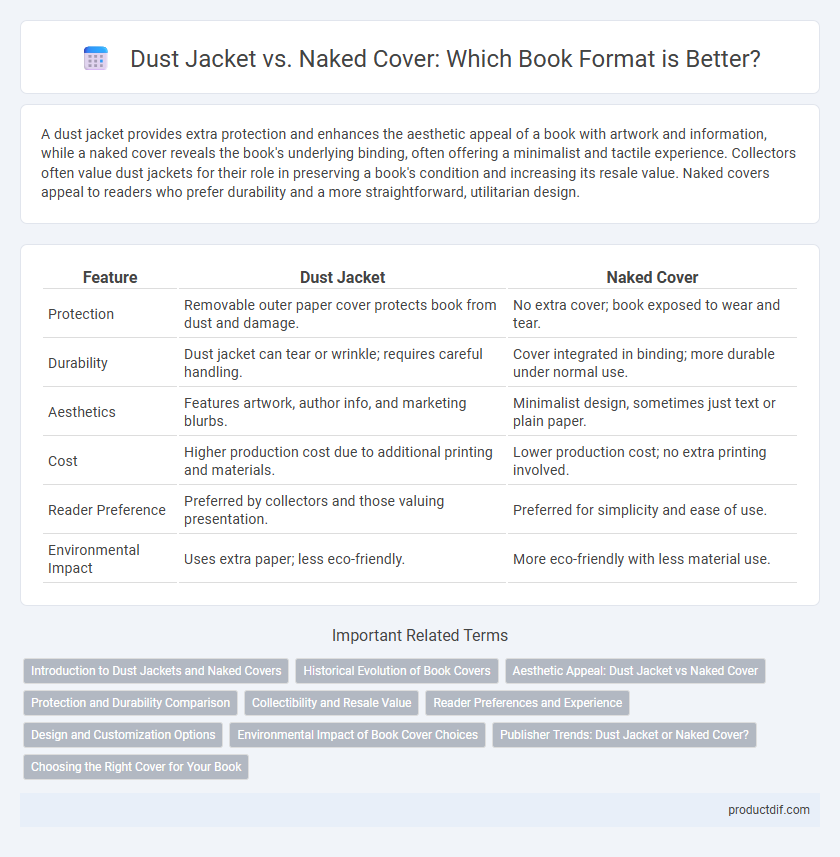A dust jacket provides extra protection and enhances the aesthetic appeal of a book with artwork and information, while a naked cover reveals the book's underlying binding, often offering a minimalist and tactile experience. Collectors often value dust jackets for their role in preserving a book's condition and increasing its resale value. Naked covers appeal to readers who prefer durability and a more straightforward, utilitarian design.
Table of Comparison
| Feature | Dust Jacket | Naked Cover |
|---|---|---|
| Protection | Removable outer paper cover protects book from dust and damage. | No extra cover; book exposed to wear and tear. |
| Durability | Dust jacket can tear or wrinkle; requires careful handling. | Cover integrated in binding; more durable under normal use. |
| Aesthetics | Features artwork, author info, and marketing blurbs. | Minimalist design, sometimes just text or plain paper. |
| Cost | Higher production cost due to additional printing and materials. | Lower production cost; no extra printing involved. |
| Reader Preference | Preferred by collectors and those valuing presentation. | Preferred for simplicity and ease of use. |
| Environmental Impact | Uses extra paper; less eco-friendly. | More eco-friendly with less material use. |
Introduction to Dust Jackets and Naked Covers
Dust jackets serve as protective coverings for books, often featuring vibrant artwork and important information like author bios, summaries, and reviews. Naked covers, also known as book bindings without jackets, expose the actual hardcover or paperback material, emphasizing durability and a minimalist design. Understanding the difference between dust jackets and naked covers highlights their roles in both protection and aesthetic appeal in book presentation.
Historical Evolution of Book Covers
The historical evolution of book covers reveals a significant shift from ornate dust jackets to the minimalist appeal of naked covers, reflecting changes in publishing technologies and consumer preferences. Early dust jackets, emerging in the late 19th century, were designed to protect fragile bindings and feature elaborate artwork that attracted buyers, while modern naked covers emphasize the book's raw aesthetic and durable materials. This transition illustrates the balance between preservation, marketing, and evolving cultural values in book production.
Aesthetic Appeal: Dust Jacket vs Naked Cover
Dust jackets enhance a book's aesthetic appeal by featuring vibrant artwork, intricate designs, and glossy finishes that attract readers and protect the hardcover beneath. Naked covers, often displaying embossed titles and textured materials, offer a minimalist, tactile experience that emphasizes the book's physical quality. Both styles influence shelf presence, with dust jackets creating visual impact and naked covers appealing through understated elegance.
Protection and Durability Comparison
A dust jacket provides an extra layer of protection against dust, moisture, and scratches, significantly extending a book's longevity compared to a naked cover. Naked covers, often printed directly on the hardcover, offer sturdiness but are more susceptible to surface damage and wear over time. The dust jacket's removable feature allows for easy replacement, enhancing durability without compromising the book's aesthetic appeal.
Collectibility and Resale Value
Dust jackets significantly enhance a book's collectibility and resale value, acting as protective covers that preserve the condition of the book's binding and pages. Naked covers, or books without dust jackets, generally have lower market value despite the content's appeal, as collectors prioritize the presence of the original dust jacket for authenticity and completeness. Rare or first edition books with intact dust jackets frequently command higher prices in the resale market due to their preserved condition and desirability among collectors.
Reader Preferences and Experience
Dust jackets offer readers added protection and often feature elaborate artwork or summaries, enhancing the tactile and visual experience during reading. Naked covers provide a minimalist aesthetic that appeals to readers seeking durability and a straightforward design without the risk of damage to a removable jacket. Reader preferences vary, with collectors favoring dust jackets for their added value and casual readers often choosing naked covers for practicality and ease of handling.
Design and Customization Options
Dust jackets offer extensive design flexibility with full-color printing, glossy finishes, and embossing options, allowing publishers to create visually striking and protective covers. Naked covers, typically featuring printed graphics directly on the hardcover or paperback, provide a minimalist aesthetic with fewer customization features but enhance the tactile feel and durability of the book's exterior. Customization options for dust jackets include flap designs and spot UV coatings, while naked covers emphasize binding quality and textured materials to differentiate the book's physical appeal.
Environmental Impact of Book Cover Choices
Dust jackets, typically made from coated paper and plastics, often contribute to higher environmental waste due to their non-recyclable materials and shorter lifespan compared to naked covers, which use the book's own cover for protection. Naked covers, especially those printed on recycled or sustainably sourced paper, minimize resource consumption and reduce landfill contributions by eliminating additional packaging layers. Choosing eco-friendly inks and certified sustainable paper further lowers the carbon footprint of naked covers, making them a more environmentally responsible option for publishers and readers.
Publisher Trends: Dust Jacket or Naked Cover?
Publishers increasingly favor dust jackets for hardcover editions to enhance visual appeal and protect the book, appealing to collectors and readers seeking a premium experience. Naked covers, without dust jackets, gain popularity in mass market and trade paperback segments due to cost efficiency and minimalist design trends. Market data from 2023 shows a 35% rise in dust jacket usage among major publishers, driven by consumer demand for distinctive, collectible packaging.
Choosing the Right Cover for Your Book
Selecting the ideal book cover involves weighing the benefits of a dust jacket versus a naked cover based on durability, aesthetic appeal, and target audience preferences. Dust jackets offer protection and customization opportunities through vibrant artwork and blurbs, enhancing shelf presence and resale value for collectors. Naked covers provide a minimalist, cost-effective option that appeals to readers seeking practicality and environmental sustainability in book design.
Dust Jacket vs Naked Cover Infographic

 productdif.com
productdif.com